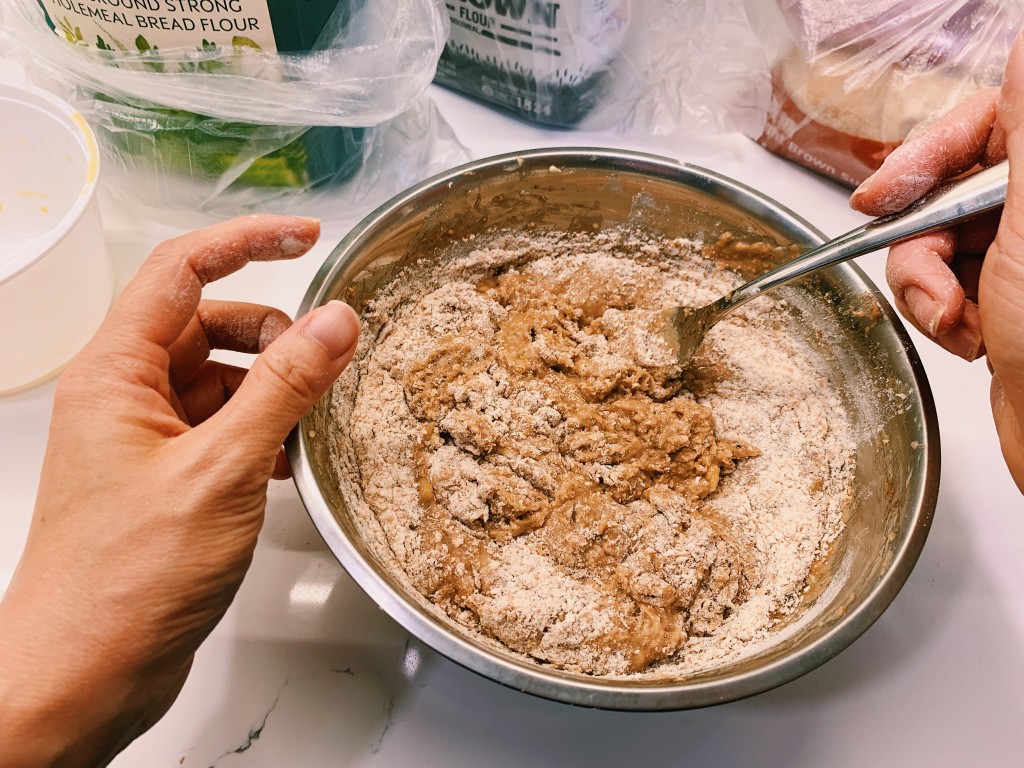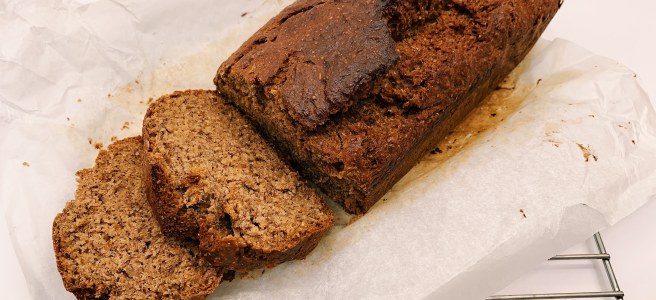
I love banana bread and banana muffins. First of they’re super easy to make compared to cakes and pies, and they just smell delicious. I like that it’s a moist bread and can pass for both breakfast and dessert (and a snack).
I have yet however to find a perfect recipe – one that’s not too moist nor too sweet. I’m not a sweet tooth so I only like my breads and desserts mildly sweet. I’ve messed around with a lot of different recipes; substituting butter for vegetable oil, reducing sugar amounts (and failing). When I finally found the one perfect recipe to my liking, I forgot to write it down so I ended up losing it forever! Drats!
Here’s my experiment and adaption from Smitten Kitchen’s Jacked-Up Banana Bread recipe. I took out the nutmeg, ground cloves and nutmeg because I didn’t have any of these at home. I reduced the amount of sugar (as I always do with all muffin and banana bread recipes as they’re usually too sweet for me). I substituted vanilla for honey, because I didn’t have any honey. I also broke up the flour and used 75% wholemeal bread flour plus 25% all purpose flour. I try to eat as much non-processed as possible for my skin, so I’ve researched a lot on how I could incorporate healthier flours without compromising on texture and taste. All purpose flour isn’t as nutritious – I know that white wheat flour has most of its kernels stripped from it (the bran and endosperm to be exact), leaving only the germ. Nutrients from those layers are thus also removed. I try to mix in whole wheat flour whenever I can, but I never swap it 100% if the recipe calls for all purpose flour, because it makes the whole thing heavy, dense and sometimes and dry like baking bread went wrong. I’ve tried swapping it 100% in the past, it didn’t work (and most pros don’t recommend it either). All purpose flour combines hard and soft wheats, so when used in muffins and moist breads like banana bread, it gives it that light airy texture. References for flour types: Martha Stewart, Cooks Illustrated.

Banana Bread Experiment #1 Recipe
Ingredients
3 medium-sized ripe bananas (spotting), smashed
1/3 cup (about 85ml) melted salted butter
1/2 cup (125ml) light brown sugar
1 egg, beaten
1 teaspoon honey
1 teaspoon baking soda
Pinch of salt
1 teaspoon (3 grams) cinnamon
1/2 cup (125ml) all purpose flour
A little more than 1 cup (270ml) organic wholemeal bread flour
Directions
Preheat oven to 350F / 180C. Smash bananas in a bowl. Mix in cold butter (use melted butter for moister / fluffier results). Mix in the sugar, egg, honey and finally cinnamon. Give it a good mix. Add in baking soda and salt, then mix. Add the flour last, mix again. Bake in a 9-inch pan for 55 mins, or until done. Cool on rack. All mixing done by hand.
Tasting and baking modification notes
- Sweetness – when straight out of the oven, its the perfect amount of sweetness for me! Reducing it from 3/4 cups down to 1/2 seems just about right – last time I halved the sugar amount and the bread turned out to dry, crumbly and almost floury. Update the next two mornings: flavour is increasingly sweeter each day and also slightly drier. I could also taste that tang of the honey, so further refinement required again in another recipe.
- Flavour – the banana flavour is a little mild using three bananas, might want to try four bananas next time or three really large ones for true banana flavour.
- Texture – not too moist and almost crumbly (but not quite). Could do with a bit more moisture. The wholemeal bread flour seems to have worked here in this ratio, not too dry. Drier on subsequent mornings, may need to reheat slightly each day before eating.
- Cold butter instead of melted better. Melted butter makes the finished product moist without affecting the integrity, so it’s usually used when making muffins or bread. I was lazy today and didn’t warm up my cold butter beforehand, so I just sliced it in. Cold butter is usually used in cakes, puff pastries, pie doughs and scones – as the cold butter melts while baking, the steam from it creates air pockets, rendering the final product to have flaky, layered texture. Would be keen to try subbing this for vegetable oil next time. Reference: The Kitchn, Bon Appetit.
- Mixing by hand – works every time! Don’t think this recipe needs a mixer and wouldn’t make the process much faster either (probably more things to wash up than it’s worth)
- Pan size – mine is 13.75″ inches, so I folded up the baking sheet to try to shorten the loaf. I didn’t crease it hard enough this time and the dough spilled out into a pointy-shaped end but that’s kewl, I’ll eat this bread in any shape or form!

